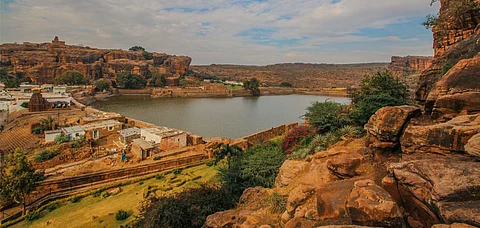
- Destinations
- Experiences
- Stay
- What's new
- Celebrating People
- Responsible Tourism
- CampaignsCampaigns
- Subscribe
- Buy Now

Located in the town of Badami and villages of Aihole, Nagaral and Pattadakal, along Malprabha river in the Bagalkot district of Karnataka is a treasure trove of cave temples dating back to the Chalukya Dynasty (6th-8th century CE).
At the mouth of a ravine between two rocky hills, the cave temples of Badami overlook the man-made Agastya lake. The place, earlier known as Vatapi, is situated around 150 km from the town of Belgaum and about 510 km from Bengaluru, and about 20 km from Pattadakal, a UNESCO world heritage site. Closeby is the 5th century Bhoothnath temple, Badami Fort and the Archaeological Museum.
Badami was the erstwhile capital of the Chalukya dynasty whose rulers were passionate about the arts, architecture and literature. They built the stunning rock-cut cave temples with a series of exquisite sculptures carved from the sandstone cliffs. The architectural stunner consists of four rock-cut caves dating back several centuries.
The caves are part of a UNESCO-designated World Heritage Site candidate under the title "Evolution of Temple Architecture &ndash Aihole-Badami-Pattadakal".
Aihole is about 35 km from Badami and about 10 km from Pattadakal. This designated UNESCO heritage site has Buddhist, Hindu and Jain monuments. Aihole's monuments are scattered around a small village full of innocuous farmlands and sandstone hills.
As the UNESCO page on the structures states, "the temples at Aihole, Badami and Pattadakal are the largest, earliest group of monuments which comprehensively demonstrates the evolution in Hindu rock-cut and temple architecture in India. The prototypes of 16 types of free-standing temples and 4 types of rock-cut shrines were developed in Badami and Aihole, which reached its most matured form in Pattadakal. This transformed the Malaprabha river valley into a &lsquocradle of Temple Architecture&rsquo, where experimentation defined the components of a typical Hindu Temple."
It's best to stick around and see the caves as the sun sets, bathing the sandstone in a deep red hue.
